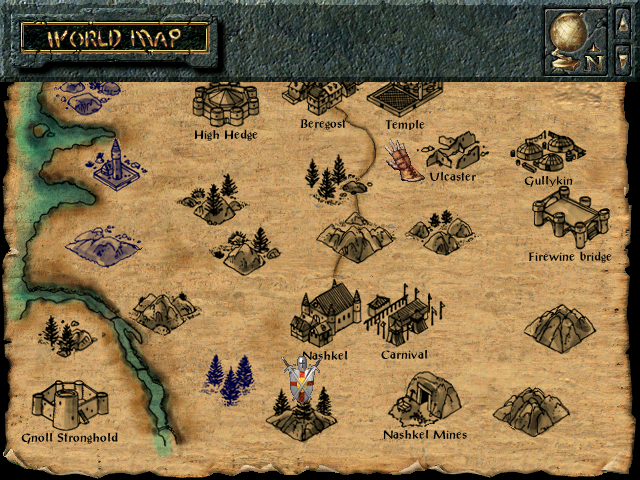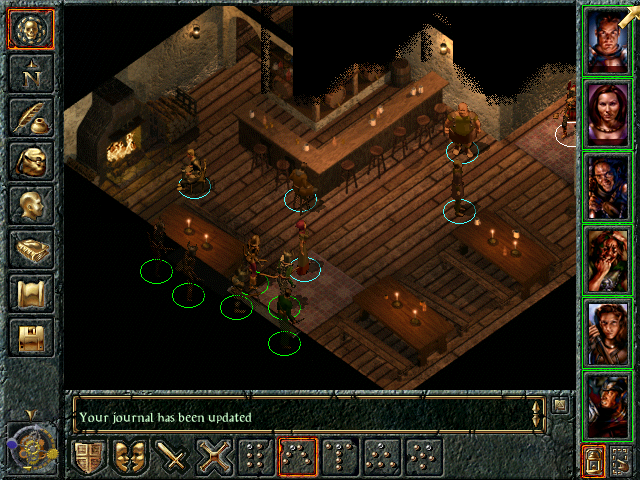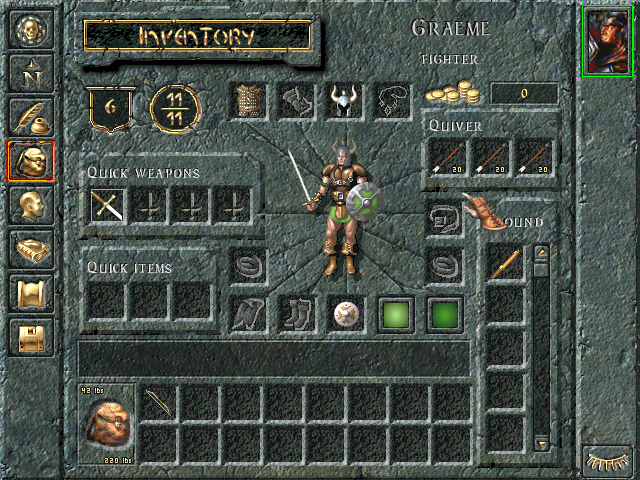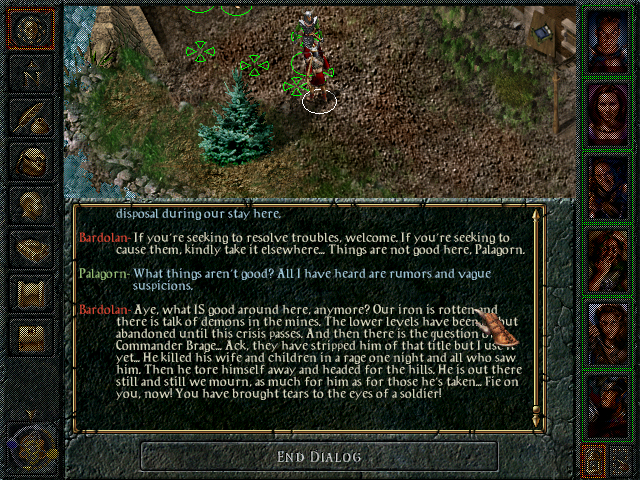How BioWare revolutionised the RPG
Inside the making of Baldur's Gate, and the forging of a legend.
20 years ago, video game RPGs were either stagnating or going from strength to strength. How could it be both these things? The answer depends, as usual, on perspective. Fans of the genre had recently been enjoying the original Fallout, a turn-based apocalyptic world that would eventually morph into the much-loved series of today.
Yet even with PC gaming enjoying a huge surge in popularity, the RPG remained a relatively niche type of game on a platform dominated by first-person shooters, flight simulators and real-time strategy titles before, in 1998, BioWare and Baldur's Gate changed that forever. Founded in 1995 by medical doctors Ray Muzyka, Greg Zeschuk and Augustine Yip, the Canadian developer began life by publishing Shattered Steel, Brent and Trent Oster's mech simulation, to moderate success. A series of events then conspired to realise what would become the most successful RPG of the decade, and for some time to come.

Baldur's Gate began life as Battlegrounds: Infinity, a tech demo of an engine devised by Scott Greig, one of BioWare's first employees. Around the same time, the developer's publisher, Interplay, secured the Dungeons & Dragons licence from TSR, and were keen to publish a video game that emulated the famous world.
"My first week [at BioWare] was the Shattered Steel launch party," says Luke Kristjanson, writer and narrative designer on BioWare's breakthrough hit. "It had started as a pitch/demo for an original fantasy IP game. As I heard it, they took the pitch to Interplay and said, 'we like D&D, so it's similar to that'." That Battleground Infinity demo became the basis of the famous Infinity engine, and when Interplay suggested BioWare utilise its D&D licence, the pieces fell into place.
Today, James Ohlen is known for his design and creative involvement in a number of best-selling BioWare series. In 1995, he was a fresh-faced Dungeons & Dragons fan, just starting out in the industry. "There were these three doctors who had started a video games company and were looking for people to work for them, for, I'd like to say, peanuts!" he laughs. "Scott had his engine, and there were six of us joining, a group of friends from Grand Prairie. I think we kinda doubled the company." In a common theme with the Baldur's Gate team, neither Ohlen nor his friends had any development experience; they did, however, share a common love for the famous tabletop role-playing game. "D&D has been part of my life since I was 11 years old. So Baldur's Gate was the chance for me to present what I thought would be a great D&D-style RPG."
Joining BioWare at this time was artist and designer Dean Andersen, also a fan of the TSR classic, although on a more aesthetic level. "When I was about ten years old, I started collecting all the different D&D modules, maps and books," he remembers. "I didn't have a firm grasp of how to play the game, I just loved the art and fantasy of the reference books." The chance to combine this with another of his passions, video games, was quite something for Andersen. "Oh man. To say that I was very excited to work on a D&D video game would be a drastic understatement. The opportunity to marry my two favourite passions into one focused endeavour...and get paid for it?!"

For Andersen, that focus was the game's art, specifically world and environment. "It was great to work with designers, writers and concept artists to imagine and bring to life the encounters and scenarios that previously were only in our collective heads when playing table top." The planned scope and scale of Baldur's Gate hit home as its gargantuan map was sketched out. "I remember when we plotted out the total world map, its dungeons and interiors. I realised that this game was over ten times the explorable size of one of my all-time favourite games, Legend Of Zelda. My mind literally imploded. Literally." Fortunately, given the previous occupation of BioWare's founders, Andersen was swiftly reconstructed after this implosion so he could return to work on Baldur's Gate.
But before world designs had been sketched out, Ohlen and his design team had already pondered on how Baldur's Gate would actually play, and it's here where the game began to morph into the behemoth that kick-started an RPG revolution. "I've always felt that you can go too far in the story direction, and also too far in the combat and exploration direction," explains the defacto lead designer, also a perennial pen and paper dungeon master. "As a DM, I always married these together, so you get something that got the power gamers involved in the story, and the story people involved in the combat and tactics, both of them appreciating the sides they wouldn't normally like."
Like Andersen, for Ohlen, working on the game was a dream come true. "From 1996 to 2000 I slept at work, and was famous as the only person who used the shower at work. I remember when Diablo came out, the whole office shut down for a week; even Ray and Greg were playing it. I refused until six pm Friday, then joined in until Sunday. I was living and breathing the game, but it wasn't work for me." As an early writer of dialogue and plot, Ohlen ceded much of this to Kristjanson, who joined shortly after development had begun. "One of the skills I've always had is to recognise when someone is better at something than I am. When I first started on Baldur's Gate I was the only designer-writer, before Luke and Rob [Bartel] came on."
For Kristjanson, the early stages of development were all about establishing style and tone. With no dedicated conversational tools to implement, many of his initial dialogues were prototyped in Word using hyperlinks. "We were also figuring out the way the story would be divided and delivered," he adds, "and what player choice even looked like, and what range of protagonist motivations we could maintain without going insane." The 'BioWare style' emerged from the team deciding what 'felt right' in terms of plot and characters, and this was, critically, informed by everyone's experience of the tabletop game.

Incredibly, despite their love of D&D, not one of the team behind Baldur's Gate had had one iota of video game creation experience. Fortunately, Interplay's own development house, Black Isle Studios, became useful allies. "They were good mentors for us," remembers Ohlen, "and we benefited from having an experienced group of game developers show us the ropes. And it helped that it was a very collaborative effort; every day we would have design meetings with me, Ray, Scott and the art director. Then I might work on the dialogue for a character, and if we actually had the tools, script what the characters were gonna do, and attach the dialogue files."
Ohlen's commitment to creating a game that balanced between action and traditional RPG resulted in the tactical pause, a mode where the player could stop the action while they selected weapons and targets, or mull over tactics. It was a system born from the clash between Ohlen's love of the real-time strategy genre and Muzyka's favoured turn-based style. "It was our way to both win," smiles Ohlen. "We had a real-time game that satisfied fans of RTS, but one that also satisfied turn-based fans."
Like Andersen, Kristjanson also collected RPG core books, making characters and backstories of his own. "But I didn't get into playing with other people until university. I did a year-long D&D campaign, and when the DM moved on, we switched to Champions. I mostly play bards. Wisdom is my dump-stat!"
By the time Kristjanson arrived, a number of story revisions had already been processed. "The original pitch was considered too big for a starting campaign, although major elements of that would later feed into Baldur's Gate 2." It was clear there was a difference in idea of scale between TSR and BioWare, especially when the former suggested a low-level save-the-village-style campaign. The game's design was a balance in other ways too: trying to reconcile the twin-RPG audiences, those experienced in the genre, and the casual fans that the game was trying to attract was one issue. Another was the balance between Dungeons & Dragons loyalists, TSR's 2.5 changes to the RPG, and the reality of adapting a pen-and-paper game to the computer screen.
"The bulk of my days were outlines and writing, because I wrote something like 60-70 per cent of the game," continues Kristjanson. "But there was so much to do. When not working through the critical path, followers or talking with James, I would comb levels for places to put story books. And because the art department more-or-less had free reign to dress the spaces between critical locations, filling it was never-ending." To help with this, the writer spent weeks referencing modules and sourcebooks, incorporating characters and locations, or just purely inspired by the scope and variety of scenarios such as Dragon Mountain.

Meanwhile, over in the art department, the diversity of Baldur's Gate made every day a challenge. "Sometimes we'd be figuring out how to render in a true isometric perspective - 3D content was just emerging back then - or assembling geo and painting backgrounds," remembers Andersen. "Or we were figuring out advanced water shader techniques, using dithered textures or lighting the scenes for day/night transitions. It really varied quite a bit." But it wasn't just the in-game graphics that defined the look of the RPG; the character portraits and other art, painted by Mike Sass, also helped make Baldur's Gate a beautiful and involving experience. And for Andersen, it gave the chance for his wife to be immortalised forever in the BioWare classic. "She was initially pretty cool with the idea of modelling for the portrait [of Imoen]," he recalls. "And it wasn't until years later when the two of us were at a trade show that a fan recognised her. Then, she understood the importance of it, and how deep nerd-blood runs!"
As development on Baldur's Gate ran past its slated two-year cycle, it was clear the game was going to hugely eclipse the imagination of both Interplay and TSR. With DVD still in its infancy, the result was a mammoth five CDs, stuffed full of orcs, fireballs and evocative locations. "We knew the game was going to be big, and Interplay were actually very supportive," says Ohlen. "We wanted to make part of the appeal that it was this grand-scale, open-world RPG where the player could go anywhere. We knew this would mean multiple discs." BioWare were also tentatively considering the possibility of making the game into a trilogy, and certain parts of Baldur's Gate were designed accordingly. "We wanted the player to be able to create a character not just for the one game, but the trilogy," says Ohlen. "So for example, we couldn't let them have all the levels at the beginning." This experience cap frustrated many gamers back in 1998, but begun a trend of character importation that has been since refined for further BioWare series such as Mass Effect.
Released at the end of 1998, Baldur's Gate was an outstanding success, and swiftly became the strong platform for BioWare to become the success it is today. Despite the new technology, the inexperience of the team and huge breadth of game they were attempting, gamers flocked to buy the an RPG that combined the best of two worlds, a wonderfully in-depth and exciting gaming experience.
"I think it really comes down to the characters, story and the ability to interact with it," says Andersen. "There had been many epic fantasy games before; but we set out to create something closer to a table-top experience, and the nuances you get from interacting with other narratives, and an evolving story." Yet despite this, characterisation was something Ohlen feels the game lacked in retrospect. "I remember talking favourably about our characters as the game had been so successful. But when someone mentioned the Final Fantasy games, I went and played them and realised they had real relationships and romances."

The team recognised its own characters were essentially one-dimensional, often just mouthpieces for the situation the party found itself in. It was something that was corrected for the inevitable sequel, explains Kristjanson. "The followers were all pretty basic once they were in the party; we had 24 [followers] in Baldur's Gate, and all of them combined had less dialogue than Jaheira in Baldur's Gate 2."
Speaking of characters, the majority of them were based on personalities from Ohlen's own campaigns. "All my friends, everyone from my hometown has a character," he tells. "For example, Cameron Tofer, his character was Minsc, and Cam was never serious about D&D, so he said I'm gonna name my character after a Russian city, and I'm gonna buy him a hamster." Being a fan of the Spelljammer campaign, the giant space hamster became Boo, actually just a normal run-of-the-mill earthbound rodent, with Tofer starting a running joke that resulted in one of the series' most memorable followers.
As Baldur's Gate's deluxe box, containing a five-CD wallet and lengthy manual, flew off the shelves, BioWare was already working on an expansion, Tales Of The Sword Coast, although the main game wasn't without its detractors. Some hard-core RPG fans disliked its focus on combat; the multiplayer, despite a potent idea in theory, lacked cohesion, as party members paused everyone else's screen while swapping out items; and pathfinding was a notable criticism, as party members often wandered to their destination via a nest of deadly spiders, rather than the safe road selected by the player.
By giving players something they hadn't seen before, an intricate and huge open world, with the freedom to tactically approach any situation, this was RPG entertainment of the highest calibre. It set in motion careers, launched a phenomenally successful developer, and changed the shape of its genre forever. "There's an honesty to it, as it's the game we wanted to play, the game we'd already been playing, sitting round a table with a party of misfits, who maybe weren't friends, but soon would be," remembers Kristjanson, one of only a handful of BioWare personnel from the Baldur's Gate team remaining.
"We knew it was good, and it changed how TSR and Interplay viewed us. We went from a tiny licence in Canada to selling a downright threatening amount of games." Deep within BioWare HQ is Kristjanson's office; above his desk, on the wall, is a picture of the entire studio in 1997. "It's 38 kids I barely recognise, myself included. I look at that face and think, 'man, you did not know what you were doing'. But that's great and I don't want to lose that. Not knowing what we were doing meant we had to come up with something new, and that's what keeps me excited working here."









